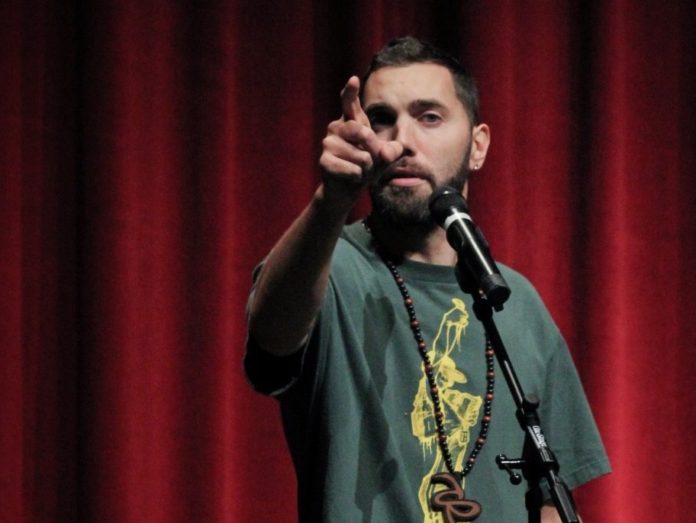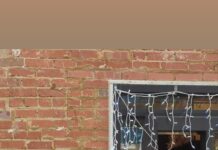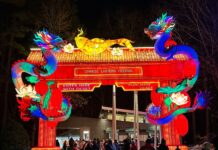
Kane Smego, a hip-hop poet and educator who attended Chapel Hill High School roughly two decades ago, returned to Hanes Theatre on August 29 to perform excerpts from his new autobiographical one-man show.
Combining spoken word, hip hop and poetry, the show, Temples of Lung and Air, looks at Smego’s identity through intersecting lenses of family and race. The 90-minute performance ran at PlayMakers Repertory Company at the University of North Carolina at Chapel Hill (UNC) from August 22 to 26.
Smego shared several segments from Temples of Lung and Air during 3rd and 5th periods, including a story about being caught between “left and right” growing up with his white mother and her black boyfriend and, during the summer, with his white father’s family in West Virginia.
Another segment from Temples of Lung and Air shown in Hanes is about sensing the roots of hip hop during a cypher (a freestyle-rap gathering) in Harare, Zimbabwe. He said on stage that his students in Harare told him that dancehall, a Jamaican genre that inspired elements of hip hop, was “the music of the hood” there. Trying to teach them about hip hop, he remarked, is like “teaching glaciers about the rhythms of river water. I’m preaching to the source.”
Smego also delivered on stage a verse from the anthemic rap song “North Cack,” his collaboration last year with G Yamazawa and Joshua Gunn. And he led the audience through a time-travel poem stuffed with historical references from Julius Caesar to his 1990s childhood.
“What I loved about the performance was the truth and depth of the words he was saying,” junior Julia Rinehart said. “Beautiful imagery and metaphors were woven into topics that are not pleasant to speak about. Nothing was sugarcoated, and it was apparent that he put his heart and soul into the material that he writes.”
Living in Los Angeles, Smego works remotely with Next Level, an intercultural hip-hop enterprise based in Washington, D.C. He manages two hip-hop residencies a year; upcoming locations include Morocco, Guatemala and the Dominican Republic. He also teaches and performs poetry at colleges and K-12 schools around the United States.
“Oh, wow, people like my poetry”
In Temples of Lung and Air, Smego traces his involvement in spoken word back to a cassette of Kris Kross’s Totally Krossed Out, released in 1992. He, along with friends in Durham, soon wrote verses of their own. Smego began keeping a journal for rap and poetry, though after he moved to Chapel Hill-Carrboro for middle school he lost some interest in hip hop.
As a sophomore at Chapel Hill High School, Smego’s English instructor was Michael Irwin. “I just liked him as a teacher,” Smego said. Irwin brought students to Day of the Poet in Durham to attend poetry workshops. “Then there was a final open mike if folks wanted to share. I shared a poem, and I think Irwin heard it then,” he said. “That was the first time being like, ‘Oh, wow, people like my poetry.’”
Smego left North Carolina in 2002 to finish high school in the Midwest with his father. But Smego kept in touch with Irwin, who invited him to help at his Scene and Heard workshop once he was back in Chapel Hill to work. At rehearsal Smego watched high-school friends practicing spoken-word poems and, inspired, wrote one of his own for the show.
Presenting his life story
Later that year, 2006, the youth poetry slam Brave New Voices was held in New York City. “Irwin asked me to join the team,” Smego said. “We went up there, and that was my introduction to spoken word, poetry slam and all that. That was a big game-changer.” Smego started performing at poetry slams and open-mike events in the Chapel Hill area.
“When I was a rapper growing up, and I was exposed to spoken word, I was like, ‘I’m a rapper. I want to rhyme every time.’ And then my [slam-poetry] coach challenged me to write a poem without rhyming, which then made me really focus on other literary devices—simile, metaphor, personification, imagery.”
“It all starts from just trying things,” he said. “The best way to get good at things is always to do them and go watch people or read people who do them better than you. That was and continues to be the recipe for me—write and share some stuff, be willing to fail and stick with it.”
Had he been unwilling to move past three-minute poems, Smego would not have developed Temples of Lung and Air. He started it by compiling some pieces he had previously written, including the Zimbabwe story and one called “The Border” about artificial authority.
“I just started writing pieces and figuring out which ones belonged next to each other in conversation,” he said.
In February 2017, Smego brought the unfinished script to the Process Series at UNC. While “thinking about what was possible” to add, he said, dramaturge Elisabeth Lewis Corley gave him suggestions of what to rework, organize or expand. After a week of experimentation, Smego and other artists gave live readings of their revised works.
Between the Process Series and the PlayMakers staging, Smego added details about living out west with his father while he finished high school. He said friends told him he had “glazed over the story” in too few lines, given that his father was “a main person in the show, and part of this complex relationship.”
In “a very collaborative, conversational give-and-take,” Smego said, the performance was enhanced by lighting, sound and set designers at PlayMakers. Directed by Joseph Megel, head of StreetSigns, which co-produced it with PlayMakers, Temples of Lung and Air ran for five days in late August.

Smego’s mother attended most nights of the performance, and her longtime boyfriend, Burly, who is a focal point of the story, came on Friday night, as well as aunts, uncles and friends.
“Some nights you feel it deeper, and I think that was from audience energy. A matinee might be more subdued, whereas Friday night, the late show, had a really young crowd, mostly college students. They were reacting to different lines,” Smego said. “In the hip-hop parts, they were a lot more loud and the energy was different, which changes the way that I perform in some ways.”
The responsibility of a white rapper
A goal of the performance is “encouraging people to challenge people in their networks, in their inner circles,” Smego said.
“We tend to have the most influence on and ability to have tough conversations with people we’re close with, like friends and family,” he said. “You can love people that you love, but when your friends make homophobic comments, or your grandparents make racist or sexist comments, try to challenge those things and remember that change happens in our daily interactions with people.”
Smego said he has a professional duty to engage professionally with issues that affect black people. All white hip-hop artists must “be committed to the people from which a culture comes,” he said, and not remain silent on such issues, “whether it’s people getting killed in the street or debates over Confederate monuments being up or coming down.”
“I see my work as trying to build bridges—to create art that enables conversations between folks,” he said, “and inspires people to try to answer questions they have about themselves and other people, interrogate some of their own biases and tell their own stories.”
Smego’s next projects are musical, including the forthcoming song “Doubt(ers)” with G Yamazawa and plans for an album.











